Samsung QE55Q7F Review
Samsung QE55Q7F
The colours! Oh the colours!
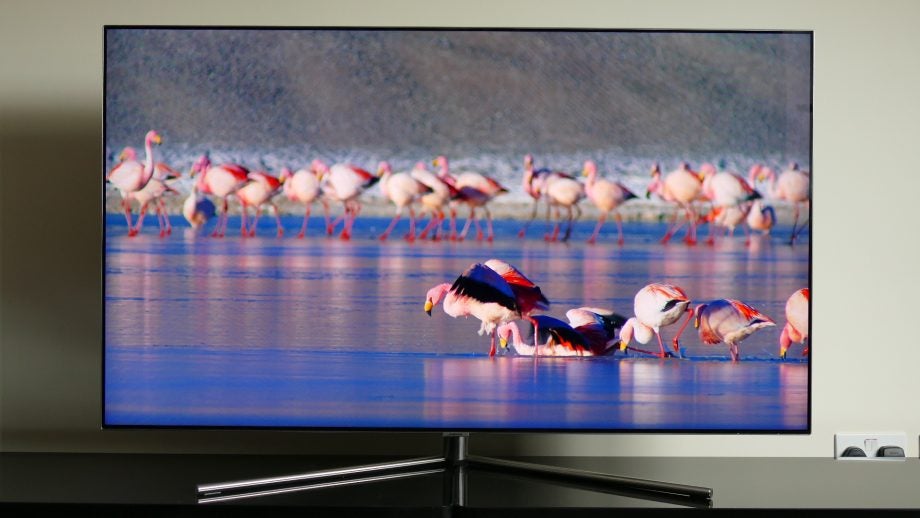
Verdict
If you love colour and brightness, then you should check out this TV
Pros
- Bright with lovely colours
- Strong contrast
- Premium build and design
- External connections box
Cons
- Occasional lighting issues
- Expensive
Key Specifications
- Review Price: £2299.00
- 55-inch screen size
- 4K UHD resolution
- HDR10 and HLG compatible
- 1500 nits peak brightness
- UHD Premium certified
- Edge lit with local dimming
What is the Samsung QE55Q7F?
Welcome to Samsung’s 2017 VIP table. Here you’ll find the QLED series, which sits at the top end and replaces last year’s SUHD range.
The QLED series is a three-strong lineup made up of the Q9, Q8, and Q7. We’ve tested the Q9 and the Q8 – check out our reviews of the Samsung QE65Q9FAM and the Samsung QU55Q8C – so let’s look at its more affordable sibling.
Is it good? Oh yes – it’s very good. In some ways, the Q7 is a huge step above even last year’s flagship Samsung KS9500. Just as with the Q9, there are a few lighting-related drawbacks, but these are eclipsed by colour performance that I can only describe as groundbreaking.
Prices start at £1999 for the 49-inch version (not available in the US), going up to £2299/$2799 for 55 inches, £3099/$3999 for 65 inches, and £4999/$5999 for 75 inches. The Q7 is available in flat and curved variants, labelled Q7F and Q7C respectively – and a quick look at Currys PC World shows that the curvy model will cost an extra £200 across all sizes.
What we have here is the 55-inch flat version – officially the QE55Q7FAM, or QN55Q7FAM in the US.
Related: What is QLED?
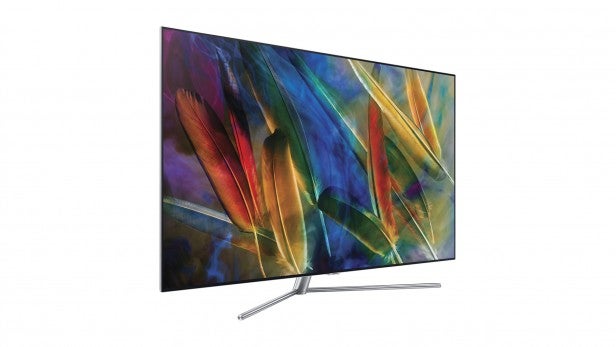
Samsung QE55Q7F – Design
Take one look at this TV and it’s plainly obvious that this is a Samsung premium TV.
There’s a lot of metal. The frame is made from metal, as is most of the stand and the remote control. Even before you turn it on, there’s a luxurious vibe that goes some way towards justifying this TV’s price tag.
The rear of the QE55Q7F is made of plastic – but it’s solid, and the bit of texture separates it from the dull black back panels you see on most TVs. In addition, the back of the stand can be opened up to hide cables – a nice touch.
As is now tradition with Samsung’s top-end TVs, all of the connections and ports (besides power) are housed in a ‘One Connect’ box. The idea is to make it easier to plug in other items – I’ve injured my back on a number of occasions squirrelling behind TVs to play with cables.
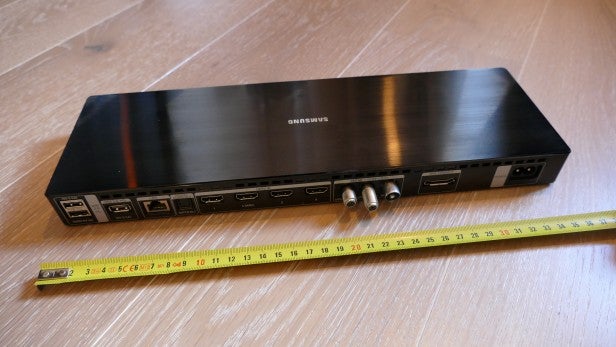
It’s welcome when it comes to aesthetics, too: you don’t have a nest of cables hanging from your shiny new purchase, plus annexing the brains theoretically means the entire TV is slimmer overall.
Connections are generous, as I’d expect from a premium model: four HDMIs (all 4K and HDR compatible), three USB ports, Freeview and Freesat tuners, optical out and Ethernet. This box is bigger than previous iterations (about 35cm long), which makes tucking it away a little trickier, but I managed to hide it behind my Panasonic DMP-UB700 4K Blu-ray player without too much difficulty.
This One Connect box needs its own power cable, however, which is a first. It seems to confirm my theory that it houses a significant chunk of the TV’s brains. So you’ll need two mains sockets for the Samsung Q7, which is a little annoying.
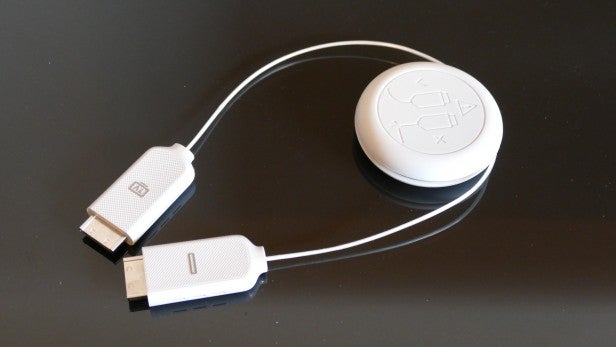
At least you get a 5-metre long cable running from the One Connect box to your TV, so you can have your AV system some distance away from the screen, should you wish. I could set up the Q7 in my bedroom, down the corridor from my test lab, with cable to spare.
Samsung has made this cable super-thin; it’s just 2mm thick and looks a little like fishing wire. When I first saw the Q7 at Samsung HQ, I didn’t actually see the cable. The flip-side to this invisibility is that it’s delicate. It’s fibre optic, so don’t bend it at 90 degrees. And keep it away from pets – my rabbit would chew through it in seconds.
I’ve mentioned the remote already, but I feel compelled to do it again. It’s lovely. The button layout is virtually the same as last year’s simplified ‘smart’ remote, only now it’s mostly made of a sort of machined aluminium, which feels lush. It has the quality I’d expect from luxury brand Bang & Olufsen, which is high praise indeed.
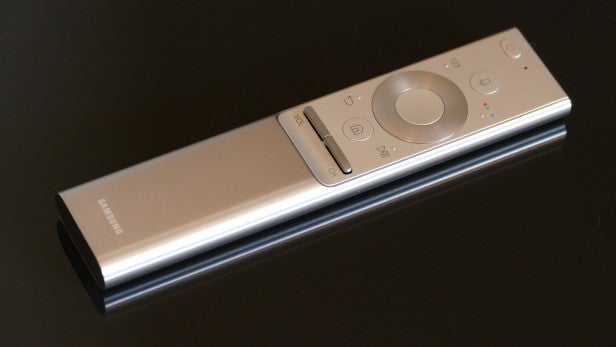
Samsung QE55Q7F – Features
Samsung is making a lot of noise about QLED, so let’s tackle this first. You can read our guide – What is QLED? – but here are the essentials.
QLED is a term that’s been bandied around for a while now, but here it refers to Samsung’s latest evolution of its Quantum-Dot technology. Basically, Samsung has wrapped its Quantum Dots in a metal alloy, which allows them to be pushed harder and placed closer to the front. This, theoretically, results in a greater range of colour, brightness and contrast, as well as better viewing angles.
Related: Best TV Deals
I should stress this has nothing to do with the mythical emissive QLED tech that’s been theorised for years, which is a little more like current OLED standards. Samsung’s QLED still uses LED LCD panels.
Speaking of LED – this is an edge-lit TV. None of Samsung’s top TVs offer full-array backlights this year, which shows how much confidence the company has in QLED.
Watch: OLED vs QLED
Time for some specs, and the Q7 effortlessly qualifies for a UHD Premium sticker. It boasts a peak brightness of 1500 nits. This is a little less than the 2000 nits claimed by the top-end Q9F, but up from the 1000 nits from last year’s brightest.
That’s on top of its 4K UHD resolution and its 10-bit colour compatibility, which translates to over a billion shades. It can handle high dynamic range in HDR10 and HLG (Hybrid Log-Gamma). There’s no support for Dolby Vision, but Samsung has been working on its own metadata-friendly alternative, called HDR10+. While that’s bound to cause yet more confusion in an already chaotic HDR landscape, it’s nice to know that it’s an open format, which Amazon has already signed up to.
Last but not least, there’s no 3D. Like nearly all the other TV manufacturers, Samsung has decided it’s dead. As far as I know, the only 3D option in 2017 is the Panasonic EX750.
Related: Panasonic’s entire 2017 4K HDR and HD TV lineup
Samsung QE55Q7F – Performance
When it comes to picture quality, the Samsung Q7 is a treat. There are some lighting-related caveats, but for the most part I’m happy to say that Samsung has reached new heights of HDR performance – at least where brightness and colour is concerned.
I tested the Samsung Q7 against a Samsung UE65KS9500 (the flagship model from 2016 and one of last year’s best TVs) and the new Sony KD-65A1. The Q7 fared well.
The Q7 not only manages to bump the brightness past last year’s 1000 nits, it also achieves greater detail in the light. It goes nicely with the pin-sharp 4K resolution.
My latest favourite test disc is the Planet Earth 2 UHD Blu-ray, and one of the best scenes for checking out bright detail performance is in the Mountains episode, where eagles fight over a dead fox.
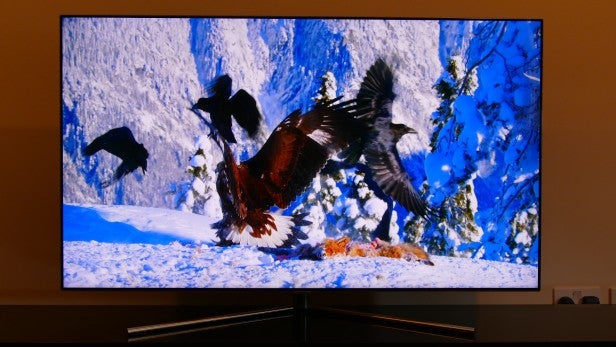
The snowy battleground is displayed with aplomb. There’s a remarkable amount of texture in the snow that’s kicked up, considering the TV was operating at full brightness for most of the frame. I pushed the Sony A1 OLED to its brightest, and there wasn’t as much differentiation in the whites. This is exactly the sort of thing that makes a strong case for the continued use of LCD in HDR pictures.
The contrast is impressive, too. Compared to the KS9500, the overall picture is more striking – whether you watch it in SDR or HDR. That’s some achievement. The blacks are a little deeper, the highlights are little brighter, and the light-reducing ‘moth-eye’ filter works well to reduce reflections, even with my lights on full and the curtains pulled back.
And then there are the colours. Oh, the colours. This is the single greatest strength of the Samsung Q7, and a compelling argument for QLED. I had been under the impression that Samsung did a great job with the colours on the KS9500, but the Q7 makes that look flat by comparison.
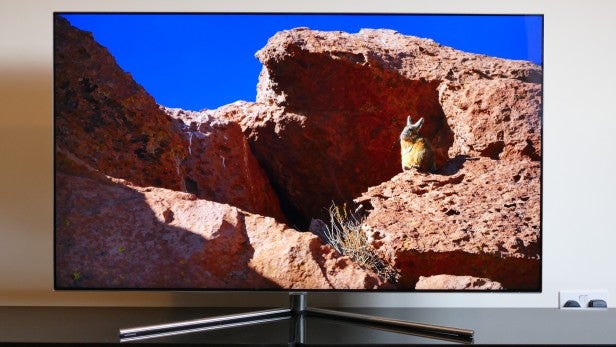
The Q7 looks richer, with greater variety to shading. Despite the brightness of the snowy battle scene, the eagles and the dead fox are nicely saturated. At such brightness you’d expect some washout of colours, but they remain vivid. I switch to the hummingbirds scene in the Jungles episode, and the Q7 does an excellent job of conveying their iridescent feathers with all their shifting sheens and subtle blends. It isn’t just more colours, either – skin tones look more natural, too.
I was also impressed by the motion of the Samsung Q7. There’s little in the way of artefacts and trails, and definition isn’t impacted by fast movements.
It’s safe to say that the Samsung Q7 does a great job of handling HDR content, but Blu-rays and DVDs look good too. 1080p is effectively upscaled with minimal noise. Standard-definition content is inevitably blurrier, but pictures aren’t too soft.
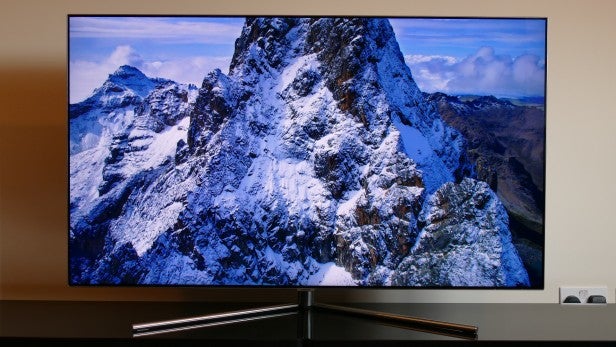
I did mention there were some lighting-related drawbacks, however. Blacks aren’t uniform: there’s noticeable blooming when there’s a bright object on a dark picture – say, the headlights in the HDR Amazon series Bosch. I also spotted some clouding in the corners, plus shadow detail could be better. It’s here that OLED maintains an edge – although it doesn’t get as bright, dark scenes don’t suffer from strong highlights.
Occasionally, I also noticed some bands of light, no doubt a result of the edge lighting. Samsung has achieved great things here – brightness, colour and contrast I never thought possible on an edge-lit TV – but I can’t help but feel that this TV would be even better with full-array backlight. No doubt it would make the TV’s form thicker, but I could live with that.
Finally, viewing angles aren’t great. This was one of the great selling points of QLED, and I’d seen impressive viewing angles from Samsung’s prototypes, but it doesn’t seem to work as well in practice. I lean left and right on my sofa, 2.5 metres from the screen, and I can see the contrast fading. It’s best to stay within 30 degrees from centre.
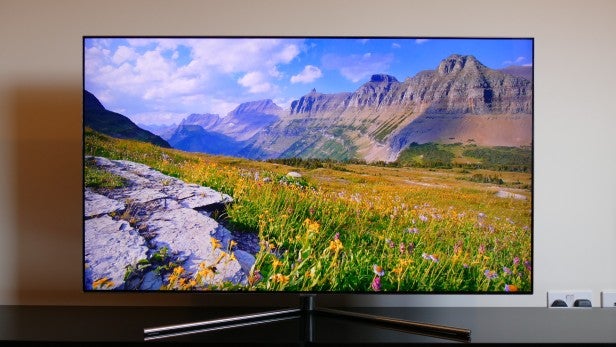
Setup tips: I like to use a tweaked version of the Standard preset. I tend to watch TV in similar lighting settings, so I turned off the Eco settings, which include an ambient light sensor. Switch off motion processing (or have it on manual if you must, with de-blur and de-judder set to very low). For HDR performance, set Local Dimming to standard or high, but keep Contrast Enhancer off to avoid loss of detail. Also, bumping the gamma setting to plus one or two helps a little with shadow detail.
A quick note on audio: while the Samsung Q7 doesn’t have the fancy no-speaker sound system of the Sony A1 OLED, it does a perfectly fine job. It gets plenty loud without hardening up, and there’s a decent tonal balance. Voices are clear yet weighty, and the Countdown theme displays plenty of dynamism.
It’s certainly good enough for day-to-day usage, and I’d go so far as to say it’s sufficient for the odd movie too. It isn’t a proper cinematic sound, so don’t expect much bass weight or extension, nor much in the way of effects placement, but I don’t feel compelled to insist you invest in a soundbar.
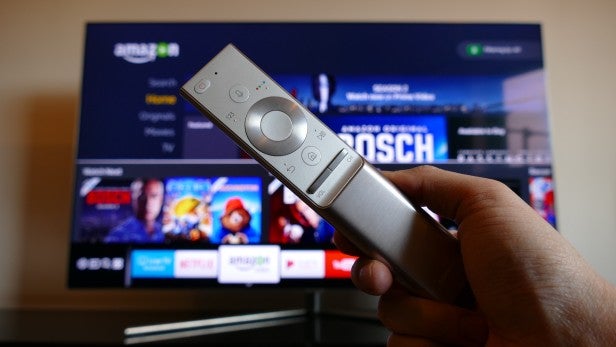
Samsung QE55Q7F – Software
The software has noticeably improved from last year. It’s still using a launcher bar smart hub, but the speed and responsiveness is significantly better. There’s no stutter or delay, even when you first power it up. Switching between an input (say, a UHD Blu-ray player) and an app is seamless. I like the way the app tiles offer up your most recently viewed programmes, so you can jump straight in without first going to an app’s homescreen.
You get the 4K and HDR versions of Netflix and Amazon Video, too. There’s also Google Play Movies and YouTube, plus BBC iPlayer and ITV Hub, but no sign of All 4 and Demand 5. Since there’s no YouView or Freeview Play integration, you don’t get the full suite of UK catch-up services – as you do on the Sony KD-65A1.
I’m surprised to say that I’m happy about the return of voice control. This existed on Samsung smart TVs a few years ago, but it was a bit useless. Now it actually works. It isn’t anywhere near as smart as the Amazon Fire TV Stick’s Alexa-based voice system, but it’s handy for when you don’t want to manually click through menus. Just hold down the button on the remote and say “HDMI three” or “Brightness 10”.
When Samsung first floated its Tizen launcher bar a few years ago, I felt it was a pale imitation of LG’s webOS. Today, I reckon it stands on its own as a clean, intuitive interface.
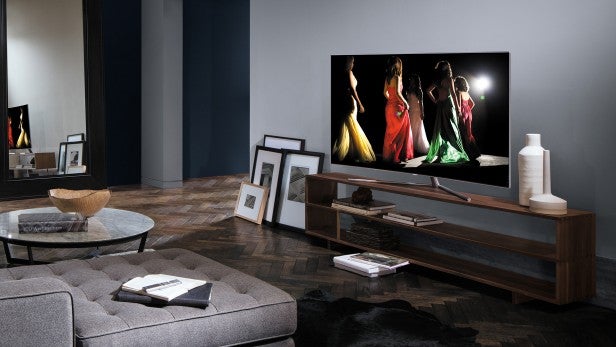
Should I buy the Samsung QE55Q7F?
The Samsung Q7 is seriously impressive, and I can see QLED holding its own against OLED for a few years yet. Its advantages significantly outweigh its flaws, and I’m super-impressed by its handling of brightness and colour. It’s certainly expensive, but if you have £2300/$2800 burning a hole in your wallet then this is a good way to spend it.
As ever, if your priority is black uniformity and shadow detail, it’s best to stick to OLED. The new Sony A1 OLED costs more at £3500 for the 55-inch version, but the the Philips 55POS901F OLED is now £2500.
Related: Best TVs to Buy
Verdict
QLED proves that the battle for HDR dominance is far from over. If you love colour and brightness, check it out.
How we test televisions
We test every TV we review thoroughly over an extended period of time. We use industry standard tests to compare features properly. We’ll always tell you what we find. We never, ever, accept money to review a product.
Trusted Score
Score in detail
-
Value 8
-
Smart TV 8
-
Image Quality 8
-
Design 9
-
Sound Quality 8

